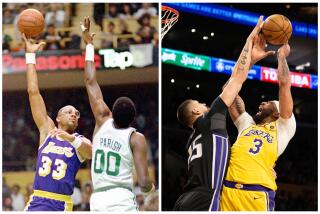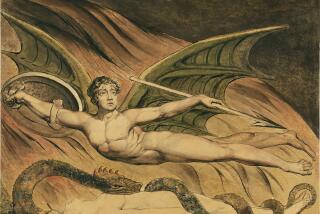Blake Was Down a Break
- Share via
It was not as if Robby Ginepri had expected to see anything like this in his athletic career. He is, after all, a tennis player, not a boxer or race driver, where life-threatening situations are part of the sport.
But there, on a dreary, drizzly day in Rome last May, was his friend, James Blake, not moving and face down on a clay court where they had been practicing.
“I knew it was bad,” Ginepri said recently. “I was shocked.”
Each had lost in the first round of the Italian Open. Each needed more work on the clay courts of Europe, with the French Open coming up. So their coaches found some clay courts away from the Italian Open venue and arranged for Ginepri and Blake, as they often did, to play a match against each other. The stakes, as always, were high.
“We were playing butts-up,” Ginepri said. “That means that the loser of the set had to stand on the baseline, bend over with his butt facing the net and the winner gets to take one good serve at him from his service line. Most of the time, we miss.”
So at 4-4, when Ginepri tried a drop shot against his occasional American Davis Cup teammate, Blake had no choice, with stakes this high, other than to run it down.
“He is just so fast,” Ginepri said, his voice trailing off with the realization that nothing more needed to be said.
Speed was only one of the reasons Blake had become such a force in professional tennis. He had become a Davis Cup regular, worked his ranking into the top 30 and had become, with the inspiration of his hero Arthur Ashe, the fourth African American to win an ATP Tour event in the Open era, the 2002 Legg Mason Classic in Washington, where one of his victims en route to the title was Andre Agassi.
Others reasons for his success were dedication and work ethic, which meant that chasing down Ginepri’s drop shot, even in practice, was a given.
The court was a little slippery, a little sticky. Just as Blake got close to the ball, and the net, his foot stuck, he lost his balance and he lurched forward, sending him head-first into the metal net post. There was no time to throw his hands up, no time to react.
“I heard a thud,” Ginepri said. “He hit so hard, the net shook.”
Much of what took place after that remains a blur. Blake had been able to move his head just enough at the last second to avoid the kind of direct hit that would have snapped his neck backward and possibly resulted in permanent paralysis. But even by hitting the post on the back of his neck, he fractured a couple of vertebrae.
“I remember thinking later,” Blake said, “that if I went head in, I would have been like the football player, Dennis Byrd. That kind of paralysis. I remember hoping I’d be able to walk again. I wasn’t thinking about playing tennis.”
Blake’s longtime coach, Brian Barker, and Ginepri’s occasional coach and friend, John Thompson, were there. Somebody ran to call an ambulance. Everybody hovered around. At some point, with Blake not saying anything but able to move his fingers and toes a little, Ginepri and the coaches tried to turn him over. That, in retrospect, was probably a bit of a risk, but it did no further damage.
“We held his head straight,” Ginepri said. “We had to get his face out of the clay.”
They covered him with jackets and waited for the ambulance, which took about 25 minutes to arrive. When it did, paramedics put Blake on a board on a stretcher with his head stabilized and kept him like that for three hours.
*
The tennis career of the phenom from Harvard had taken a terrible turn in 2004. And there was more to come.
After a hospital stay in Rome, Blake returned to his family home in Fairfield, Conn., where his father was beginning to fade quickly from cancer. They had time to talk, to play golf, to do the things that life on the tennis tour does not permit. Blake says now, with no hint of sarcasm, that breaking his neck was one of the best things that ever happened to him.
Thomas Blake died in July, just before the start of a grass-court tournament in Rhode Island. James was scheduled to play and his father had insisted, no matter what. So he did, won a round and then came down with what he thought was an ear infection. It turned out to be shingles, a disease often triggered by stress.
Now, Blake had a rash on his head and the left side of his face was paralyzed. That meant that his left eye didn’t blink naturally, would stay open at night when he slept and wasn’t getting the normal moisture needed. Eventually, the paralysis went away, but the vision in his left eye remained blurred, not a good thing for somebody whose job it is to return 135-mph serves.
He tried to make a comeback late last year. He jokes about the time he was playing Vince Spadea, went wide to his right to hit his favorite shot, a running forehand, and swung and missed.
“The eye still isn’t 100%,” he said recently. “It still feels strange when I blink it fast, four or five times. I hope it continues to get better.”
His vision is quite clear, however, on the perspective he gained from 2004.
“The whole thing made me appreciate everything more,” he said. “I get up in the morning and look out and can smile and see it is a nice day. I don’t take that for granted anymore. I can see clearly. I can move my neck.
“And I’m back on the court. That makes me happy.”
*
Blake is getting there, but he might not quite be ready for prime time. Doctors have given him estimates of between six months and a year and a half for him to feel, and be, totally recovered from his 2004 ailments.
The first major step was the Australian Open, where Blake, 25, took eventual finalist Lleyton Hewitt to four sets in the second round. He played through to the quarterfinals two weeks ago in Scottsdale before losing to Spadea, and he is in Indian Wells now for the Pacific Life Open, which starts the men’s main draw Friday.
Despite falling to No. 151 in the rankings, he is in the main draw because tournament director Charlie Pasarell gave him a wild-card entry. The tennis world knows his story, undoubtedly making the decision on Blake’s wild card one of the easiest ever for Pasarell. In the first round, Blake will play 57th-ranked Alberto Martin of Spain.
But for the foreseeable future, it is more about perspective than wins and losses for Blake.
He was asked recently about how it felt to have to watch from the sidelines as the United States played a Davis Cup match in Los Angeles without him.
“I’m not ready for that,” he said. “I shouldn’t have been picked or considered. I would have loved to play in front of the home fans, but I’m not there yet.”
He and Ginepri are closer. The bond is there. Ginepri recently had a charity event in Atlanta, and Blake came to play. And in interviews about his situation, Blake quickly gets around to telling how, just weeks after his accident in Rome, Ginepri had a similar scary incident in a tournament in Dusseldorf, when he dashed toward the net to retrieve a drop shot.
“I just was able to stop in time,” Ginepri said. “I didn’t think about James when it was happening because there was no time, and I was just able to catch myself by grabbing the net. But now, when I think about it, that was freaky.”
Ginepri is in the Indian Wells draw too, so chances for practice sessions will be there, depending on how far each advances.
That means that fans attending the tournament who wander out to the practice courts just might see some strange doings. It will be the end of a practice set and one player will bend over on the baseline, facing the back wall while the other hits a serve at him as hard and fast as he can.
Then, hit or miss, they will laugh loud and long, the kind of laugh that comes only from those who share something personal.
More to Read
Go beyond the scoreboard
Get the latest on L.A.'s teams in the daily Sports Report newsletter.
You may occasionally receive promotional content from the Los Angeles Times.











